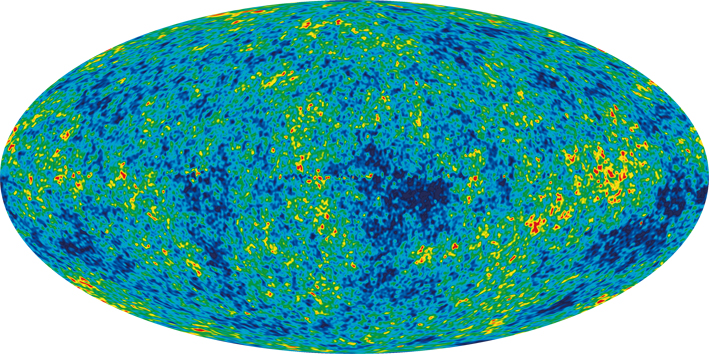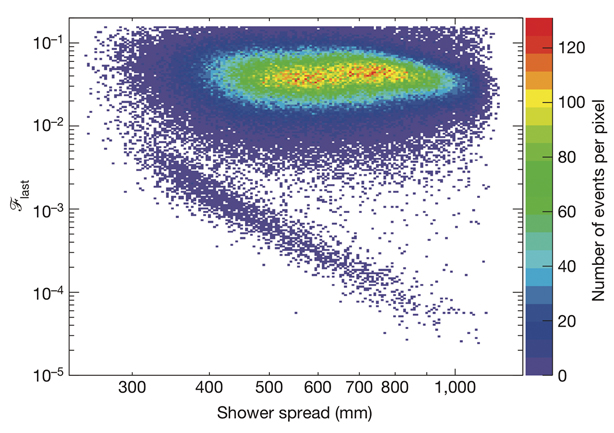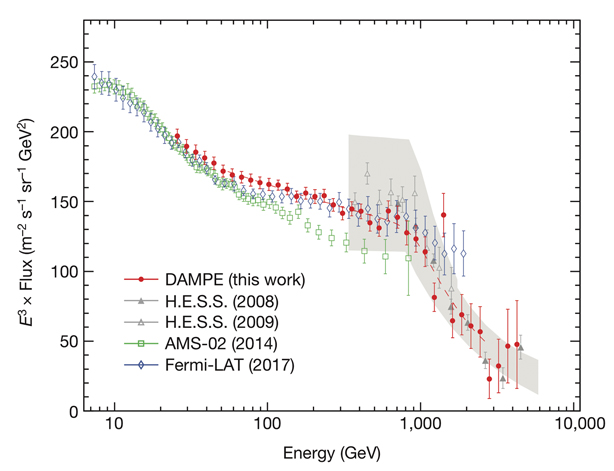By SONG Jianlan (Staff Reporter)
“Here we report a direct measurement of cosmic-ray electrons and positrons in the energy range 25 gigaelectronvolts to 4.6 teraelectronvolts …” The Dark Matter Particle Explorer (DAMPE), also known as “Wukong” in Chinese, reported in Nature on Dec 7, 2017 the initial findings from its first 530-day observation. With its precise measurement of cosmic ray electron flux, especially the refined spectral structure in the energy range of ~0.9 TeV and beyond, this international collaboration evoked renewed enthusiasm about the hermit matter.
Nick-named after Monkey King, the hero in the classic Chinese tale “A Journey to the West” who has strikingly sharp eyesight to tell true colors of any amorphous spirit or monster, DAMPE is expected to track traces from a hypothetic kind of particles predicted to constitute dark matter, one of the most elusive things in the cosmos. Literally, “wu” and “kong” in combination mean “understanding the void.” Could what DAMPE has delivered help us penetrate the darkness? The debate is on, together with hope.

Dark matter, which first manifested itself in the 1930s as the “missing mass” in some otherwise unexplainable astronomical observations, remains one of the most elusive things to-date in the cosmos. It is so “dark” – it never gives off or absorbs light as ordinary matter – that it escapes conventional measures of observation; it is so quiet and eccentric – it does not interact with ordinary matter – that so far no one knows what exactly it is, despite large-scale experiments aimed at catching its whereabouts, including the observations made by the Large Area Telescope aboard the Fermi Gamma-ray Space Telescope (Fermi-LAT) and the VERITAS ground-based gamma ray observatory.
Obscure as it is, dark matter takes much bigger a share of matter in the cosmos than ordinary matter. The latest evidence shows that it accounts for about 26.8% of the total mass-energy of the cosmos, while ordinary matter takes only about 4.9%; the rest 68.3% is taken by another invisible and elusive existence, the dark energy. Moreover, dark matter plays an essential role in astrophysics. Without counting it in, the pursuit of many basic questions would be impossible: its phantom-like existence shadows the models explaining the origin and evolution of the cosmos, influencing the large-scale structure of the universe, and the formation of stars and galaxies. It might even help explain the very subtle fluctuation in the cosmos microwave background (CMB) – the primordial afterglow of the Big Bang.
Among the numerous models predicting its properties and derivative behaviors, the “weakly interacting massive particle” (WIMP) represents the most promising or the most attractive one for physicists. According to this model, dark matter is a kind of heavy particles that only interacts with each other through gravity and the weak force. Scarcely as it occurs, once they really bump into each other, they annihilate and give off high-energy gamma-rays and other ordinary particles or anti-particles, like electrons and positrons. In other words, once they “die,” their remnants fall into the secular world and become visible for electromagnetic observation, therefore (hurrahs) can be indirectly detected by refined apparatus.
Such events occur very rarely in the cosmos, as predicted by physicists. Besides, another major difficulty inherent in such indirect searches is possible false anomalies produced by various astrophysical sources other than dark matter: many alternative sources can mimic the signal expected from dark matter. To solve the problem, an effective detection needs to pick up multiple signals and track their trajectories to discriminate different particles from each other, judging from their different performance in energy development. On top of this, collation of profiles from different observations and analysis of the nuances of the datasets, which are of essential importance, might lead to different conclusions.
Chances are thin, but bright enough to prompt physicists from different countries to invest intensive efforts in the global search for this hermit particle. Many experiments have been launched for this sake, including space experiments like the Alpha Magnetic Spectrometer (AMS-02) on the International Space Laboratory and ground-based experiments like the High Energy Stereoscopic System (H.E.S.S), aside from the Fermi-LAT experiment mentioned earlier. AMS-02 aims to search for antimatter in the cosmic rays and H.E.S.S., a system of Imaging Atmospheric Cherenkov Telescope (IACT), aims to investigate cosmic gamma-rays in the photon energy range from 0.03 to 100 TeV. The major task of the Fermi-LAT observation is to perform an all-sky survey aimed at studying a wide spectrum of astrophysical and cosmological phenomena, including dark matter.
DAMPE, our Monkey King Wukong, represents a new international effort initiated by scientists at the Chinese Academy of Sciences (CAS).

Invisible and unsociable without emitting/absorbing light or interacting with ordinary matter, dark matter could work as kind-of a framework of the cosmos that attracting ordinary matter to form stars and galaxies, as indicated by accumulating evidence. It influences large-scale structures, and might also help explain the anisotropy in cosmos microwave background. (Image: NASA / WMAP Science Team)
The Story of DAMPE
In the hope of catching the products from the annihilation of WIMPs, DAMPE was developed and sent into a sun-synchronous orbit by an international team led by the Chinese Academy of Sciences (CAS) on Dec 17, 2015. Funded by the strategic priority science and technology projects in space science of CAS, it represents a collaboration of more than a hundred scientists, technicians and students from nine institutes in China, Switzerland and Italy, under the leadership of the CAS Purple Mountain Observatory (PMO).

The BGO instrument built in DAMPE demonstrates a very good discrimination of CREs from protons. (Image by the DAMPE collaboration)
The idea of initiating a space mission to detect WIMPs in China first originated from a voyage in 2000 made by Prof. CHANG Jin at PMO, who later became the Principal Investigator of DAMPE mission, to the Antarctica for a balloon experiment. This Sino-American experiment known as “ATIC-2” adopted a detector competent of measuring cosmic ray electrons of very high energy. To his surprise, in an energy range where the consensus opinion anticipated a drop in the electron counts, CHANG found an abnormal excess. This abnormal observation also inspired widespread discussions, leading to the suspicion if this could have been a residual trace of WIMPs. The recorded events, unfortunately, proved to be too few to establish a statistically significant anomaly.
“Nevertheless, it was still an exciting result,” recollected Prof. WU Ji, director of the National Space Science Center (NSSC), CAS and Member of the International Academy of Astronautics (IAA). “I still remember his facial expression when I first met him in his office in 2005. He showed me the curve with great emotion, and promised with absolute confidence that they would have been able to find out whether or not the anomaly was a signal given by the high-energy product particles from dark matter annihilation, had they got a bigger detector and had released it aboard a satellite,” he continued.

Shown is a single BGO crystal, which is the longest in the world, made by the Shanghai Institute of Ceramics of CAS.
The targets of CHANG’s dream detector, the high-energy cosmic gamma-rays and other particles, are largely screened by the atmosphere of the Earth, hence can hardly be picked up on the ground. To get closer to the products from possible annihilation of WIMPs, human beings have to go to space for high-accuracy measurement.
CHANG got the support from CAS for his seemingly crazy ambition, after 6 years. The winter of 2011 witnessed the formal approval of DAMPE as a mission under the framework of the strategic priority science and technology projects in space science of CAS. Included in the scientific objectives of the mission are the study of galactic cosmic rays up to ~10 TeV and hundreds of TeV for electrons/gammas and nuclei, respectively, and the search for dark matter signatures in their spectra.

A schematic view of the DAMPE BGO calorimeter, featuring an array of BGO crystals constituted by 308 bars of BGO crystals of 60-cm length. (Image by the DAMPE collaboration)
CHANG’s ambitious plan posed critical challenges to the design of the detector, among which was the unprecedentedly wide energy coverage ranging from 1.0 GeV to ~10 TeV. This requires a million-fold dynamic range of the detector. An unprecedentedly low background is also required by the mission. It means a very good discrimination of electrons/positrons from protons and hence a very accurate measurement of signals from different sources. Otherwise it would be impossible for the downstream analysis to meet the preset requirement.
They made it. By 2014, the team had finished building the Engineering Qualification Model (EQM) of DAMPE and put it to extensive tests on different particle beams of different energy ranges at the European Organization for Nuclear Research (CERN) in the subsequent two years. The test beam data demonstrated excellent energy resolution for electrons and gamma-rays (better than 1.2% for energies exceeding 100 GeV), and verified that the electron/proton discrimination capabilities of the system are consistent with the simulation results.

A schematic view of the DAMPE detector. Seen are the four built-in sub-detectors: The plastic scintillator detector (PSD) measures the charge of incident particles, and discriminate gamma-rays from charged cosmic rays. The silicon–tungsten tracker-converter (STK) detector measures the charge and trajectory of charged particles, and reconstructs the direction of γ-rays converting into e+e? pairs. The BGO calorimeter (BGO) measures the energy of incident particles and provides efficient identification of cosmic-ray electrons and positrons (CREs). The neutron detector (NUD) further improves the electron/proton discrimination at teraelectronvolt energies. Combination of these four sub-detectors enables DAMPE to effectively reject the hadronic cosmic-ray background and improve the energy resolution for CRE measurements. (Image by the DAMPE collaboration)
The particularly high energy resolution and excellent discrimination capabilities are mainly attributed to the BGO calorimeter built in DAMPE, which measures the energy of incident particles and provides efficient identification of cosmic-ray electrons and positrons (CREs). “Central at the 1.4-ton detector of DAMPE is the BGO crystal calorimeter. The length of the built-in BGO crystals determines the size of the detecting area, which is the key to the detecting efficiency. Thanks to an excellent technician at the Shanghai Institute of Ceramics of CAS who is able to make the longest BGO crystals in the world, we achieved this amazing performance,” introduced Prof. WU Ji.
Refined Spectral Structure
In comparison with other dark matter detectors like those in AMS-02 and Fermi-LAT missions, DAMPE offers a wider energy coverage, and better ability to discern CREs from protons, hence producing broader and “cleaner” a spectrum, of unprecedentedly high energy resolution and low background contamination.
During its first 530 days’ orbiting through June 8 of 2017, it detected a total of 1.5 million CREs above 25 GeV. The spectrum in the energy range of 55 GeV–2.63 TeV, according to the team’s analysis, strongly prefers a smoothly broken power-law model over a single power-law model. Given that astrophysics generally predicts a power-law model, the new structure implies new signal sources, and this has sparked a new wave of excitement in the global physical circle.

The CRE spectrum measured by DAMPE in the energy range from 25 GeV to 4.6 TeV. Of note, the data in the energy range between 55 GeV and 2.63 TeV strongly prefers a broken smooth power-law model over a single power-law model. (Image by the DAMPE collaboration)
A comparison of the CRE spectrum delivered by DAMPE and other experiments indicates a consistency with the observation made by Fermi-LAT in the lower energy range, and due to its higher energy resolution and purity, the spectrum given by DAMPE reveals more details in higher energy zones, including some at energies that were never covered before by space CRE observations. Remarkable among them is the spectral break at ~0.9 TeV with the spectral index changing from ~3.1 to ~3.9, together with a flux declination at TeV energies. The break confirms the indirect CRE observations previously made by H.E.S.S.
According to Prof. FAN Yizhong, deputy chief designer of DAMPE’s scientific application system, the precise measurement of the CRE spectrum, in particular the flux declination at TeV energies, considerably narrows down the parameter space of models previously proposed to explain the “positron anomaly” observed by PAMELA and AMS-02. Such models range from nearby pulsars, to supernova remnants, and/or to candidates for particle dark matter.
“Together with data from the cosmic microwave background experiments, high energy gamma-ray measurements, and other astronomical telescopes, the DAMPE data may help to ultimately clarify the connection between the positron anomaly and the annihilation or decay of particle dark matter,” said FAN.
Obviously, the accurate measurement of DAMPE in this high-energy area has provided new possibilities for astrophysical research, including the search of dark matter.

The CRE spectrum measured by DAMPE in comparison with other published measurements. (Image by the DAMPE collaboration, from the Nature paper)
Phantom of Dark Matter at Large
The newly revealed details in the higher energy range, particularly at TeV energies, have inspired endless imagination and explorations. In just a week after the publication of the results, over 30 papers appeared in the online preprint community arXiv.org, contending to fix models that might best explain the refined spectral structure there, particularly the “spike” at ~1.4 TeV showing a sharp excess.
Could dark matter be hanging around at the tip of the higher end of the CRE spectrum? Given the high energy and steep declination in flux on the “spike,” Prof. ZHOU Yufeng, researcher at the CAS Institute of Theoretical Physics (ITP), analyzed that the observed anomaly could have come from nearby sources, including continuous sources and bursts; sub-halos of dark matter near to the sun could also be a possible candidate. Prof. BI Xiaojun, researcher from the CAS Institute of High Energy Physics (IHEP), partially agreed with ZHOU, commenting that the signal at the high-energy zone could have been produced by nearby sources; particularly, he said, the spectral structure could have been produced by new celestial bodies on the verge of the solar system, including pulsars and annihilation occurring in dark matter sub-halos. The two, he stressed, are both likely to be the real source; without signals from even higher energy ranges, neither one could be excluded.
The DAMPE team expressed similar caution in their Nature paper. More data are definitely required to explain the spectral structure between 1 and 2 TeV energies, they reported.
The next datasets to come from DAMPE, as accumulated in longer observation times, can offer better statistic reliability, and further allow even more precise measurement of the CRE spectrum up to ~10 TeV. This will enable scientists to better explore spectral features potentially generated by dark matter particle annihilation/decay or nearby astrophysical sources, say, pulsars.
So far, DAMPE has recorded over 3.5 billion cosmic ray events, with maximum event energies exceeding ~100 TeV. It is expected to record more than 10 billion cosmic ray events over its lifetime. The good news is, its life span could exceed five years – two years longer than designed – given the current performance of its instruments, according to the news release from the DAMPE team.
The phantom of dark matter, the solitary hermit of the cosmos, is still at large. The debate goes on, with polarized opinions.
While some excitedly explore possible mechanics underlying the distinctive spectral structure, some reserve that alternative possibility still hangs for unambiguous exclusion: What if the “break” and the “spike” were just some unusual random fluctuation?
The best answer lies in continued observation and further exploration. The DAMPE mission will continue to study galactic cosmic rays up to ~10 TeV for electrons/gamma-rays and hundreds of TeV for nuclei, respectively. In the rest of its lifetime, Wukong might be able to see through the void and catch the invisible matter. Who knows?

